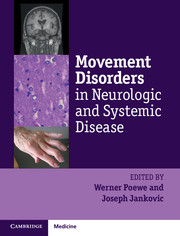Book contents
- Frontmatter
- Contents
- List of contributors
- List of videos
- List of abbreviations
- Preface
- Section I General principles
- Section II Movement disorders in systemic disease
- Section III Iatrogenic and toxic movement disorders
- Chapter 14 Drug-induced movement disorders
- Chapter 15 Movement disorders associated with chronic metal poisoning
- Chapter 16 Movement disorders following non-metal intoxications
- Section IV Movement disorders in general neurology
- Section V Systemic complications of movement disorders
- Index
- Plate Section
- References
Chapter 16 - Movement disorders following non-metal intoxications
from Section III - Iatrogenic and toxic movement disorders
Published online by Cambridge University Press: 05 April 2014
- Frontmatter
- Contents
- List of contributors
- List of videos
- List of abbreviations
- Preface
- Section I General principles
- Section II Movement disorders in systemic disease
- Section III Iatrogenic and toxic movement disorders
- Chapter 14 Drug-induced movement disorders
- Chapter 15 Movement disorders associated with chronic metal poisoning
- Chapter 16 Movement disorders following non-metal intoxications
- Section IV Movement disorders in general neurology
- Section V Systemic complications of movement disorders
- Index
- Plate Section
- References
Summary
Movement disorders may be classified etiologically as either genetic or secondary. Secondary causes include metabolic, vascular, infectious, nutritional, toxicological, and endocrine abnormalities.
Certain classes of prescription drugs, including antipsychotics, selective serotonin reuptake inhibitors, and anti-epileptics, may result in dyskinesis, dystonia, myoclonus, or parkinsonism. This subject is comprehensively discussed in Chapter 14.
Movement disorders may also occur following exposure to chronic heavy metal poisoning as discussed in Chapter 15. The nervous system is particularly susceptible to toxic insults despite the existence of specific mechanisms to prevent the entry of toxins, such as the “blood-brain barrier” and the “blood-nerve barrier.”
Here we review movement disorders that may occur following non-metal intoxications. Therefore, we will discuss those movement disorders that occur secondary to illicit drugs, alcohol, other solvents, small molecules, and natural toxins.
Illicit drugs
Recreational drug abuse can result in psychological dependence, physical dependence, or both. Psychological dependence or addiction describes a pattern of compulsive drug use characterized by a continued craving.
Physical dependence is an adaptive state in which abrupt cessation of drug use results in physical symptoms and signs (Brust 2004). Here we describe a number of movement disorders encountered in recreational drug abusers, some associated with toxicity, some with withdrawal, and some with a more indirect pathogenesis.
- Type
- Chapter
- Information
- Movement Disorders in Neurologic and Systemic Disease , pp. 234 - 246Publisher: Cambridge University PressPrint publication year: 2014



